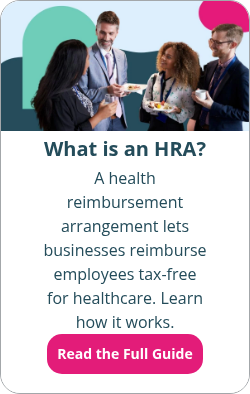What is a healthcare benefit allowance?
By Holly Bengfort on October 9, 2025 at 7:00 AM
The rising cost of health insurance has many employers wondering how they can afford coverage for their employees. Many of them find that traditional group health plans are far out of reach.
Healthcare benefit allowances are often mentioned when discussing non-traditional health benefit options. Employers searching for an alternative to typical employer-sponsored plans may wonder what a healthcare benefit allowance is and how they can make it part of their employee benefits package.
In this article, we'll explain what benefit allowances are, the differences between various healthcare benefit allowance types, and how each allowance works.
In this blog post, you'll learn:
- How to offer your employees a healthcare benefit allowance using an HRA or health stipend.
- The different types of HRAs available and how they work.
- The various healthcare services and items that you can reimburse with an HRA.
What is a benefit allowance?
A benefit allowance is an amount of money an employer provides to an employee for a specific benefit purpose. For example, you can offer an allowance for healthcare, wellness, or transportation. Employers can provide these allowances through reimbursement, with a benefits debit card, or as a taxable stipend that's added to an employee's paycheck.
A healthcare benefit allowance is any contribution from an employer for an employee's healthcare expenses. It's a broad name for plans such as employer healthcare arrangements1 or employer payment plans.
One common type of benefit allowance that's considered a formal health plan is a health reimbursement arrangement (HRA). You use legal plan documents with this tax-free benefit.
There's also a type of healthcare benefit allowance that doesn't need plan documents, which is a health stipend.
Why offer a health allowance instead of a traditional group health insurance plan?
Traditionally, most employers looking to offer a health benefit only considered group health insurance. This benefit can help employees save on their medical expenses. But often, the one-size-fits-all nature of the plan doesn't work for every employee. Employees often face deductibles, copayments, networks, and providers they didn't choose.
Group health insurance is also costly for employers. Sometimes, they pass these costs down to employees.
Health allowances such as HRAs offer a formal health benefit while giving employers full control of their expenses. Employees aren't tied to a specific group insurance plan with an individual coverage HRA (ICHRA), a qualified small employer HRA (QSEHRA), or a health stipend. Instead, they get to choose their own insurance plans with their preferred providers. They can also use their allowance to cover medical services unique to them.
How an HRA works
The first type of healthcare benefit allowance we'll cover is an HRA. Employers can use HRAs as flexible health benefits that fit almost any budget. An HRA can work either as a stand-alone benefit or alongside group health insurance, depending on the type of HRA you offer.
Here's how it works:
- Employers decide the monthly allowance that they'll offer to employees. This is how much you set aside for medical expense reimbursement.
- Employees pay for their health insurance and health services using their own money. Then, they submit receipts to their employer or HRA administrator, such as PeopleKeep, for reimbursement.
- Employers approve eligible expenses and reimburse employees up to their set allowance amount.
- Any unused portion of the allowance at the end of the year stays with the employer.
Depending on the HRA, employers can choose to reimburse their employees for individual health insurance premiums and out-of-pocket expenses for medical care. They can also limit reimbursements to cover monthly premiums only.
Some examples of HRA-eligible expenses include:
- Individual health plan premiums (with an ICHRA or QSEHRA)
- Monthly premiums for dental coverage and vision coverage (with an ICHRA or QSEHRA)
- Dental care
- Vision care
- Preventive and wellness services
- Laboratory services
- Emergency services
- Over-the-counter medication
- Prescription drugs
- Mental health counseling
Employees can choose the insurance plans, healthcare products, and medical services they want. They can easily compare policies and buy their own coverage through the federal health insurance marketplace.
HRA vs. health stipend allowance
HRAs aren't the only type of healthcare benefit allowance available. Employers can also use a health stipend to create a health benefit. This stipend comes with fewer regulations than HRAs or group health insurance, making it a flexible benefit.
Employers can set a payment allowance for medical expenses on an:
- Annual basis
- Monthly basis
- Quarterly basis
Unlike HRAs, health stipends count as taxable income for your employees. You'll also have to pay payroll taxes on the amount you offer through the stipend.
Due to their taxable nature, health stipends are best for businesses with employees who receive financial help for health insurance through premium tax credits. Employees don't have to waive their credits to take advantage of the health benefit.
However, stipends don't satisfy the Affordable Care Act's (ACA) employer mandate for organizations with 50 or more full-time equivalent employees (FTEs). Employers also can't require proof of coverage or ask for receipts for items listed in IRS Publication 502. This makes an HRA a better, more compliant option for most organizations.
Types of HRAs
This section will cover three of the most common types of HRAs available. These options can provide personalized health benefits to your employees. Depending on the type, you can offer an HRA instead of, or in addition to, a group health insurance plan.
ICHRA
Organizations of any size can offer an ICHRA. Employers can set eligibility requirements and allowance amounts according to employee classes, as well as employee age and family size. Plus, there are no caps on annual allowance amounts with an ICHRA.
To participate in an ICHRA, employees must have an individual health insurance plan that qualifies as MEC. Employees can then use the allowance to cover health insurance premiums and qualified out-of-pocket medical expenses (if their employer allows it).
An ICHRA can also help employers with more than 50 FTEs, known as applicable large employers (ALEs), meet the requirements of the ACA employer mandate.
With an ICHRA, your employees who receive financial assistance through premium tax credits have to choose between one or the other. If they're offered an ICHRA allowance that's affordable, they must forego their premium tax credits. However, if they're offered an unaffordable allowance, they can opt out of the ICHRA and continue receiving their tax credits.
QSEHRA
A QSEHRA allows small businesses to reimburse their employees for their health insurance premiums and out-of-pocket expenses. Only employers with fewer than 50 FTEs can offer QSEHRAs. All full-time W-2 employees are automatically enrolled. However, they must have a plan with minimum essential coverage (MEC) to participate. Unlike an ICHRA, this includes coverage through a spouse’s or parent’s group health plan.
If your employees had premium tax credit eligibility before you offered them a QSEHRA, and their allowance is affordable, they can no longer collect their tax credits. If their allowance is unaffordable, those employees can collect their tax credits. But they must reduce their credit dollar-for-dollar by their monthly HRA allowance.
Employers can choose whether to include part-time employees in the benefit. If they do, they must offer the benefit on the same terms to all employees.
The QSEHRA is a great option for employers who want to save on health benefits costs. They get maximum value out of their spending since there's no minimum limit for employer contributions. However, there are annual contribution limits with a QSEHRA. Every year, the IRS outlines these annual contribution limits through a revenue procedure.
Group coverage HRA (GCHRA)
HRAs aren't only an alternative to group health insurance. You can offer one alongside a group health insurance plan to cover employees' out-of-pocket healthcare costs. A group coverage HRA (GCHRA), also known as an integrated HRA, supplements a group health insurance plan. To participate, employees must enroll in their employer's group health insurance plan. You can only reimburse them for out-of-pocket medical expenses—not insurance premiums.
A GCHRA allows employers to offer a group plan of their choosing and extend their employees' healthcare coverage through an additional allowance. Employees use their GCHRA allowance to cover out-of-pocket costs. This includes expenses before meeting their annual out-of-pocket maximum. It provides an extra level of budget control for employers.
HRAs and Medicare
As of May 2025, nearly 69 million people2 have Medicare coverage. Employees who rely on Medicare can also benefit from an HRA.
The table below shows which Medicare plans work with the ICHRA, QSEHRA, and GCRHA, and under what conditions:
|
Medicare Part A |
Medicare Part B |
Medicare Part C |
Medicare Part D |
|
|
ICHRA |
Yes, if the employee is voluntarily enrolled. It only counts as qualifying coverage if it is combined with Part B. |
Yes, as long as it's combined with Part A. |
Yes. |
No. Medicare Part D isn't considered MEC. However, employees can get Part D premiums reimbursed through the ICHRA if they have individual coverage that provides MEC, such as Parts A and B, or C. |
|
QSERHA |
Yes, if the employee is voluntarily enrolled and if it is combined with Part B. |
Yes, as long as it's combined with Part A. |
Yes. |
Yes, as long as employees have MEC. |
|
GCHRA |
No. |
No. |
No. |
No. |
Conclusion
Healthcare benefit allowances are a budget-friendly way for businesses to offer healthcare benefits. Employers can set an allowance that fits their budget and meets the needs of their employees.
If you're looking to implement an HRA as your health benefit, PeopleKeep by Remodel Health has several options to fit your needs. Our administration solutions for ICHRAs, QSEHRAs, and GCHRAs make it easy to set up and manage your HRA.
We take the hard work out of managing an HRA. Our team reviews your employee expenses for IRS compliance and generates legal plan documents. Your employees with an ICHRA or a QSEHRA can shop for their individual health plans within their PeopleKeep account. Schedule a call with an HRA specialist to discuss your options.
This blog article was originally published on March 26, 2013. It was last updated on October 7, 2025.
Check out more resources
See these related articles

The ICHRA and premium tax credits: what are the rules?
With an ICHRA, the allowance amount you offer your employees can impact their premium tax credit eligibility.

5 Innovative Ways Businesses Are Using Health Insurance Allowances
How are innovative businesses using health insurance allowances? Here are five innovative ways businesses are using health insurance allowances.

Average HRA allowances by state
Discover average HRA allowance amounts by state to help employers budget and offer competitive health benefits tailored to different regions.



